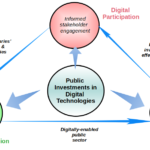We are in the midst of completing the IRRF for the new UNDP Strategic plan and the work is now focus on completing indicators while developing methodological notes. One of the indicators for outcome 3 is: Level of public confidence in the delivery of basic services, disaggregated by sex, urban/rural and income groupswhich sounds great but does not really exist.
One of the DGG colleagues working asked me about the possibility of using new technologies to make this happen, bearing in mind the data revolution, big data and crowdsourcing among others. Here is what I replied.
1. We are talking about perception based surveys which demand a lot of attention to sources and samples to be significant and be taken seriously by policy makers/public institutions.
2. The issue with current “crowdsourcing” and Internet based surveys is that participants are self-selected and thus samples are not representative of the overall population.
3. About 7 years ago we worked with Cisco and did perceptions surveys in 3 countries (Brazil, Mexico and South Africa). I had the opportunity to add some “development” questions. We focused on health and education
“services as well as participation issues. Cisco paid for the surveys which were implemented by organizations who specialize in doing just that, surveys. The results were amazing to the point than in the case of
Brazil the Ministry of Planning decided to change some of its policies to address the needs that people in the poor North highlighted in the survey.
4. Many companies, including ICT ones, do a lot of “market research” in developing economies as a way to a) decide if they invest in the country and b) and if so how much and on what specifically. Many of these companies are looking to expand coverage so they have an interest in exploring the potential of bottom-of-the-pyramid segments to see if there is a market there.
5. The Barometers undertake great work in this area and could be approached to see if they have interest in adding relevant questions on service delivery or expanding current coverage. We can also suggest to them to use “random” crowdsourcing techniques to reduce costs and expand coverage in remote areas for example.
6. Mobile telcos actually holds lots of data on their subscribers. Telefonica alone has 200 million customers in LAC. Latest estimates indicate that most developing countries will have 90% mobile net also work coverage by 2015. Unprecedented. In this light, we can approach some of them and create “innovative” partnerships (outcome 7 of the new SP) and get them to undertake randomize crowdsourcing surveys
7. At the local level, we could also target NSOs who undertake household surveys on quarterly or annual basis and request to add some relevant questions. The issue here as with the Barometers is cos . We tried this in a couple of countries but we were quoted hefty sums of cash. But again, we can get NSOs to use randomized crowdsourcing for some of the questions and for maintaining real time data at the tip of the fingers.
All in all, this can be a great undertaking which by the way related to one of the outputs in outcome 7 of the SP. We should also connect these dots…
Cheers, Raúl





